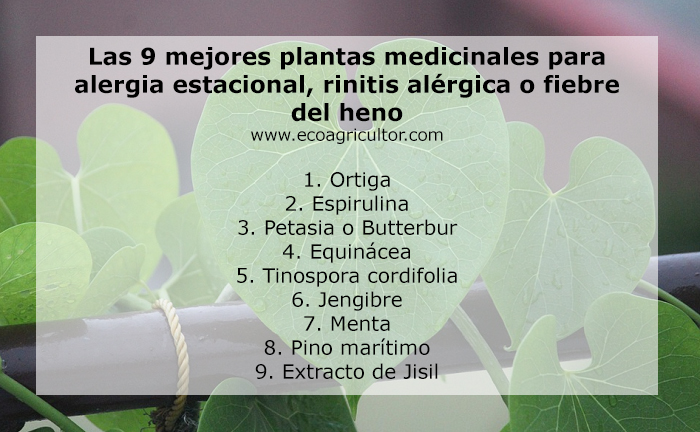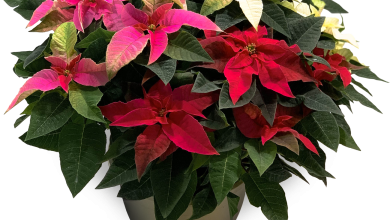The 9 best medicinal plants for spring allergy, allergic rhinitis or hay fever

What is seasonal allergic rhinitis? What causes allergic rhinitis? What are the symptoms of allergic rhinitis like? How to relieve the symptoms of hay fever or allergic rhinitis? Taste the benefits of these 9 medicinal plants.
In this article we will show you the most useful information related to seasonal allergy, hay fever or also known as allergic rhinitis so that you can solve all your doubts.
What is a spring allergy or hay fever?
When spring makes its appearance, most trees begin their flowering stage. For many people it is a beautiful time, perhaps the most beautiful of the year, however, for those who suffer from pollen allergy, it is the arrival of their ordeal.
Flowers, weeds, grasses, release pollen and cause spring allergy, constituting the highest percentage of causes of allergic rhinitis. And on sunny and windy days the symptoms worsen.
The allergic rhinitis is the medical term for the disease commonly known as hay fever, hay fever or seasonal allergies, which not only occurs in spring, you can also continue during the summer and fall.
Rhinitis is characterized by inflammation of the nasal mucosa, after exposure to an allergen. Allergens can be diverse, among the main ones we have:
- The mite dust
- The pollen
- The skin, hair and urine of certain animals (such as cats and dogs)
- Mold and mildew.
There must be a previous contact with the allergen so that the allergic person becomes sensitized and in the next touch it triggers the allergic reaction, this is because the immune system acts as a defense mechanism against these exposures and creates antibodies.
When these antibodies come into contact with the allergen, they release a substance called histamine , which is the cause of the annoying symptoms characteristic of allergic rhinitis .
Spring allergy is common in children and young people, with age the symptoms diminish.
It is important that you pay attention and recognize which allergens trigger your symptoms. For example: people allergic to ragweed will have the most intense symptoms during the fall, since unlike other flowers that produce pollen in spring and summer, pollen production by ragweed is higher in autumn.
Likewise, the probability of suffering an allergy to melons, zucchini, bananas, chamomile, and sunflower seeds or seeds is higher if you are allergic to this plant.

.
Symptoms of hay fever or seasonal allergy
In recent years the allergy to pollen has worsened and many of the symptoms of hay fever are similar to a common cold or sinusitis but unlike these, alterations in the respiratory mucosa do not disappear until the pollen is inactive.
The allergens that trigger hay fever are the same that can cause asthma, this can lead to a pollen allergy-induced asthma attack .
The symptoms of allergic rhinitis make you feel down and can affect your quality of life to a greater or lesser extent. Among the most common we have:
- Postnasal drip
- Excess mucus production
- Nasal congestion
- Sneezing
- Nasal itching
- Edema and watery eyes
- Sore and irritated throat
- Decreased concentration and focus
- Exhaustion and general weakness
- Sleep disorders
- Humor changes
- Irritability
- Urticaria
- Eczema
- Headache
- Eye bags
- Dry cough
- It can be complicated by asthma, middle ear infections, bronchitis, others.
It is difficult for people with spring allergies to control or prevent these symptoms, since the best treatment would be to avoid contact with the allergen, which is not always possible .
It is advisable that, if you suffer from respiratory or immune diseases, you treat the symptoms immediately to avoid major complications.
There are complementary natural treatments that can benefit you and reduce these discomforts. I am going to highlight some medicinal plants that have been proven useful in cases of allergic rhinitis or seasonal allergy.
The 9 best plants for hay fever or seasonal allergy
-
Nettle
An excellent antihistamine and anti-inflammatory, nettle leaf is one of the most common and touted natural medications for treating allergic rhinitis.
It contains carotene, vitamin C, vitamin K, potassium, calcium, and quercetin.
There is research suggesting 300 mg of nettle extract three times a day demonstrating a reduction in seasonal allergy symptoms.
If you are diabetic you should avoid it, since nettle can cause hypoglycemia.
Read more about the properties of nettle .
-
Spirulina
A type of blue-green algae that contains protein in addition to high concentrations of B-complex vitamins, iron, and other minerals.
A teaspoon of spirulina helps in the allergy process due to its immunomodulatory effects, inhibits mast cell-mediated allergic reactions and stops the release of histamine, being useful to alleviate the symptoms of hay fever.
Read more about the benefits of spirulina .
-
Butterbur
Popular natural medicine for allergic rhinitis, and one of the best studied.
This plant, with the scientific name Petasites hybridus , is native to North America. It works by decreasing both histamine and leukotrienes in the blood, in response to contact with allergens.
Taking a tablet of this extract three to four times a day, reduces nasal inflammation and symptoms.
Important note : when using butterbur, make sure it indicates that it is «UPA-free» (unsaturated pyrrolizidine alkaloids). This alkaloid is naturally contained in the plant and when the product is marketed it must be eliminated, since they are toxic. May cause cross-allergic reactions in people with ragweed allergy.
-
Echinacea
Immunostimulating medicinal plant, frequently used for the common cold and allergies.
Echinacea reduces the chances of catching a common cold by 58%. Its use is frequent in people with spring allergy.
It stops the viral cold, in addition to alleviating the symptoms caused by diseases of the upper respiratory tract, acute sinusitis, pharyngitis and others.
Similar to butterbur, Echinacea is a relative of the ragweed family and in case of allergy to it, its consumption should be avoided, as it can worsen symptoms in some people.
Read more about the properties of Echinacea .
-
Tinospora cordifolia
Commonly named as «Guduchi» it is known for its application in the treatment of various diseases in traditional Ayurvedic medicine.
The extracts of this plant have active components in the form of alkaloids, glycosides, lactones and steroids.
They all have different physiological and immunomodulatory functions, making it a very versatile plant. It works by reducing the release of histamine from cells.
It is used for allergic rhinitis as 300mg three times a day has been shown to reduce the symptoms of hay fever , such as sneezing, itching and a runny nose.
-
Ginger
Very good antihistamine, with anti-inflammatory and antibacterial properties, it helps with nasal congestion in the chest and headaches, in addition to strengthening the immune system.
You can drink ginger tea daily to achieve the desired results, or chew a thin slice each day.
Learn more about the properties of ginger .
-
Mint
Plant widely spread and cultivated in many regions of the world. It is a perennial shrub, easy to spread and can grow almost anywhere.
It is widely used in traditional medicine to cure ailments, topically, orally and as aromatherapy.
It has decongestant and anti-inflammatory properties, peppermint tea relieves allergies and is often used in hay fever .
Find out what mint is for .
-
Maritime pine
Pine bark extract (Pycnogenol) is used, its components improve allergic rhinitis , inhibiting the release of histamine from cells and reducing inflammation.
Its use is recommended weeks before the allergy season, 50 mg twice a day, at least one month before, reduces ocular and nasal symptoms.
-
Jisil extract
Widely used in traditional oriental medicine as a remedy for inflammation and allergies.
Its common name is bitter orange, it is a small shrub, its fruit is the part of the plant that is used, it is edible with a bitter taste and an intense aroma.
It contains synephrine, which helps with nasal congestion, as well as providing stimulating effects.
It has multiple benefits: anti-aging, antioxidant, and as a skin beautifier, it is used in Korean cosmetics.
However, there are some studies that have reported that prolonged or excessive use can cause adverse effects.
Treatment must be multiple, including changes in diet and lifestyle.
Conventional medications to treat allergic rhinitis or hay fever are antihistamines, costeroids and decongestants, counteracting the effect of histamine in the body, with the problem that most have adverse effects. If you are going to take any of these medicinal plants, consult your allergy professional beforehand to see if it is advisable to take it in your particular case.
Sources
- Natural medicines in the clinical management of allergic rhinitis https://naturaldatabase.therapeuticresearch.com/ce/ceCourse.aspx?s=ND&cs=&pc=16-110&cec=1&pm=5
- https://nccih.nih.gov/health/butterbur
- Jennifer Heimall and Leonard Bielory *, Defining Complementary and Alternative Medicine in Allergies and Asthma Division of Allergy, Immunology, and Rheumatology; UMDNJ — Asthma and Allergy Research Center; New Jersey Medical School, Newark, NJ, Volume 27, 2004
- Arnold E, Clark CE, Lasserson TJ, Wu T. Herbal interventions for chronic asthma in adults and children (Cochrane Review). In: The Cochrane Library Plus, 2008 Issue 4. Oxford: Update Software Ltd. Available at: https://www.update-software.com. (Translated from The Cochrane Library, 2008 Issue 3. Chichester, UK: John Wiley & Sons, Ltd.).
- Soham Saha and Shyamasree Ghosh. Tinospora cordifolia: One plant, many roles. Anc Sci Life. 2012 Apr-Jun; 31 (4): 151–159.


![Photo of Learn to Plant Corn: [12 Steps] and Much More](https://www.complete-gardening.com/wp-content/uploads/2022/08/learn-to-plant-corn-12-steps-and-much-more-390x220.jpg)
![Photo of Beet Pests and Diseases: [Detection, Causes and Solutions]](https://www.complete-gardening.com/wp-content/uploads/2022/08/beet-pests-and-diseases-detection-causes-and-solutions-390x220.jpg)
![Photo of Prune Tomatoes: [When To Do It, Tools, Forms and Utility]](https://www.complete-gardening.com/wp-content/uploads/2022/08/prune-tomatoes-when-to-do-it-tools-forms-and-utility-390x220.jpg)